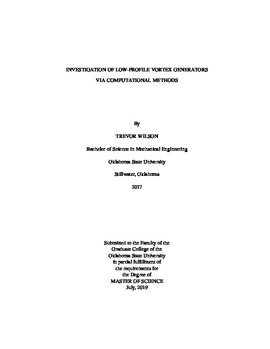| dc.contributor.advisor | Elbing, Brian | |
| dc.contributor.author | Wilson, Trevor | |
| dc.date.accessioned | 2020-01-31T15:59:58Z | |
| dc.date.available | 2020-01-31T15:59:58Z | |
| dc.date.issued | 2019-07 | |
| dc.identifier.uri | https://hdl.handle.net/11244/323435 | |
| dc.description.abstract | A unique low-profile vortex generator, termed the Conformal Vortex Generator (CVG), has recently been discovered to provide fuel saving of greater than 1% on commercial aircraft. The CVG is an adhesive backed film that creates a spanwise varying aft facing step. While the CVG has been shown to provide fuel savings, the driving fluid mechanism behind the CVG is still unknown. The current work aims to understand and validate the behavior of the CVG at subsonic conditions as well as investigate the behavior of both the CVG and traditional aft facing step at supersonic conditions. The subsonic simulations used a model based on water tunnel and flight test experiments. The goal of these simulations was validation and to provide data not available through experimentation. This study concluded that the simulations could successfully model the flow over a CVG by showing strong qualitative and quantitative similarities between computational and experimental data. It was also shown that the CVGs imparted strong spanwise variations in the boundary layer and wall shear stress that had both a Re_H and CVG length (L) to width (W) ratio dependence. The second set of simulations were based on flight scale conditions (the same as seen in the CVG real world application) and investigated the local flow physics of the CVG. These simulations were performed with a local freestream Mach number of 1.3 and an altitude of 10,000 m. It was shown that at these conditions, the CVG behavior still exhibits L/W ratio dependence and spanwise variation in the boundary layer thickness and wall shear. However, the results varied from the subsonic scaling. The CVGs also impart spanwise varying vorticity into the flow that is not consistent with a traditional step. Lastly, it was concluded that the addition of a downstream ramp past an aft facing step can mitigate the supersonic expansion fan that occurs over a step in supersonic flow. | |
| dc.format | application/pdf | |
| dc.language | en_US | |
| dc.rights | Copyright is held by the author who has granted the Oklahoma State University Library the non-exclusive right to share this material in its institutional repository. Contact Digital Library Services at lib-dls@okstate.edu or 405-744-9161 for the permission policy on the use, reproduction or distribution of this material. | |
| dc.title | Investigation of Low-Profile Vortex Generators via Computational Methods | |
| dc.contributor.committeeMember | Jacob, Jamey | |
| dc.contributor.committeeMember | Alexander, Aaron | |
| dc.contributor.committeeMember | San, Omer | |
| osu.filename | Wilson_okstate_0664M_16418.pdf | |
| osu.accesstype | Open Access | |
| dc.type.genre | Thesis | |
| dc.type.material | Text | |
| thesis.degree.discipline | Mechanical and Aerospace Engineering | |
| thesis.degree.grantor | Oklahoma State University | |
